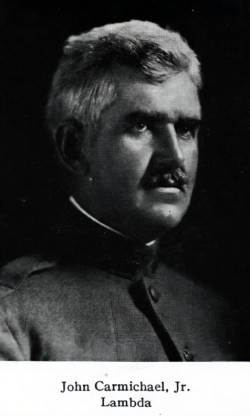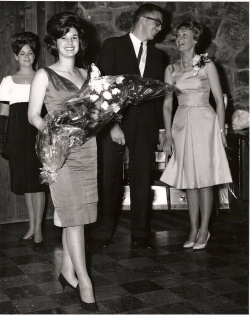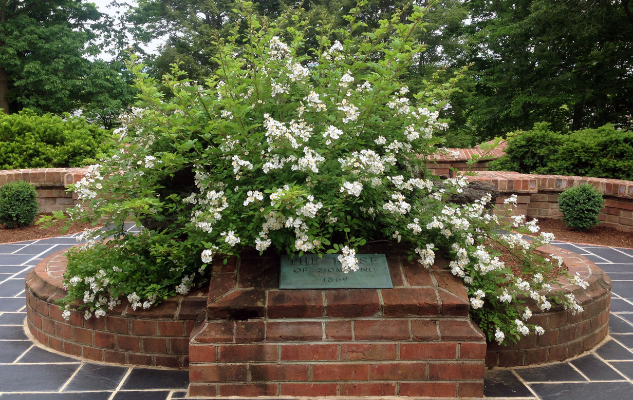Perspectives from Our Past
In my many visits to our Headquarters in Lexington, Virginia, I have only rarely seen its blooms due to its short flowering season. Most of us learned as new members that the Rose is a “white rose.” I was unaware, however, of the history of the original designation of the Rose as our flower. But I know how close we came to losing this important symbol.
The Fall 1967 issue of The Delta included an article entitled “The True Story of the Rose.” The following is an excerpt:
“Dear Sir and Brother” the letter began in the November 1891 issue of The DELTA. And, it was signed John Carmichael, Jr. (Lambda, Washington and Lee).
It was just a suggestion…but out of that letter of suggestion began a great tradition.
The missive was addressed to Grant W. Harrington…then Editor of the DELTA, and well known in Sigma Nu circles as an espouser of causes of all ilks.
“Although I have never had the pleasure of meeting you,” the letter began, “I feel as if I knew you as well as ‘my best friend.’
“I am a Sigma Nu and a Lambda Chapter man, both of which I am proud. Well, after this informal introduction, I will write business. At the next convention, I think it would be a good thing to adopt some flower as the emblem of our order, for, while our badges are beautiful, they could be made still more so by some flower. I have asked several ‘Sigs’ about this, and they seem to think it is a very good thing. I would like to hear from you about it.”
 The author of this letter was Sigma Nu’s first legacy. His father, Hall of Honor member John Carmichael, was initiated into Alpha Chapter in 1869 as the 15th member of the Fraternity. The younger Carmichael had been schooled in the Fraternity’s activities since birth and was initiated at age 15. He described himself as having “cut his first teeth on a Sigma Nu badge.” As The Delta article pointed out, “…his interest in advancing the cause of the Legion of Honor was a natural and deep one.”
The author of this letter was Sigma Nu’s first legacy. His father, Hall of Honor member John Carmichael, was initiated into Alpha Chapter in 1869 as the 15th member of the Fraternity. The younger Carmichael had been schooled in the Fraternity’s activities since birth and was initiated at age 15. He described himself as having “cut his first teeth on a Sigma Nu badge.” As The Delta article pointed out, “…his interest in advancing the cause of the Legion of Honor was a natural and deep one.”
Brother Carmichael’s suggestion was taken seriously. Hall of Honor member Carl Lane Clemans (Cornell College) formed and headed a committee to report on the Fraternity flag, flower, and yell at the 6th Grand Chapter in 1892. The report included the following, “As a fraternity flower, we recommend the white rose.” The report was approved and also codified an early flag design and the yell.
 Years passed after this, and numerous young ladies were romanced by Sigma Nus with white hybrid tea roses. Eventually, the White Rose Formals came into being, along with unofficial offshoots such as White Rose Queens—with hybrid tea roses, such as those sold by florists today, as the symbol.
Years passed after this, and numerous young ladies were romanced by Sigma Nus with white hybrid tea roses. Eventually, the White Rose Formals came into being, along with unofficial offshoots such as White Rose Queens—with hybrid tea roses, such as those sold by florists today, as the symbol.
Investigating the Rose's Origins
In 1938, Charles W. Thomas (Sewanee) was Editor of The Delta and decided to further investigate the history of the selection of the white rose as the Fraternity’s official flower. He wrote to Brother Carmichael and learned that the 1891 letter was only the first of several letters between Hall of Honor member Harrington (Kansas) and him. Carmichael had actually suggested a particular flower for the symbol.
When asked about the genesis of his original suggestion, Carmichael’s reply to Thomas, written in the third person, contained the following:
At his grandfather’s home, ‘Blandome,’ in Lexington, there was a white rose bush in the yard. The flower attracted him; he had revered it for years; possibly he associated the sentiment of living with its beauty and purity. Almost as far back as he could remember the White Rose was there for him to love and respect.
It was probably in 1892 that the boy wrote an enthusiastic boyish letter to the Grand Chapter suggesting and advocating the ‘White Rose’ as Sigma Nu’s flower.
The story could theoretically end there, but it doesn’t. The wild, white rose of Blandome did not offer the traditional large rose bloom common today but bloomed in spurts in late spring and early summer as small five-petaled blooms. The plants certainly live up to their name as “wild,” as they defy restrictions to their sprawling growth, stretching wherever sunlight, good air, and free real estate exist. The plant is both hardy and fickle, withstanding the long Shenandoah winters but susceptible to too much human interference.
The multi-petaled blooms of the hybrid teas in use today are very different from those of the original rose. The original rose’s blooms are simpler in shape but are reminiscent of the shape of the Sigma Nu badge and contain two of its colors, gold and white. The hybrid tea rose, widely used by chapters to represent the floral symbol of Sigma Nu, has its place in the Fraternity, too, and its use is correct, even though it may not be the “official” Sigma Nu flower.
Bringing the Rose to Headquarters
In 1958, when Sigma Nu’s Headquarters was moved to Lexington, Executive Director Richard R. Fletcher (Penn State) went on a mission to locate a fragment of the original Rock. Succeeding at that, he sought the original Rose bush at Blandome, a historic home which is two blocks down the hill from the Headquarters building.
Blandome was purchased in 1872 by John Randolph Tucker, the first dean of the Washington and Lee School of Law. His wife, Laura, supervised the property’s landscaping. At some point during the Tucker’s residency, which lasted until 1902, a wild white rose bush shrub was planted. In the same year the Tuckers moved into Blandome, they welcomed a new son-in-law with the marriage of their daughter Virginia to John Carmichael, who was an Assistant Professor at VMI and one of Alpha’s earliest initiates. Brother Carmichael only taught at VMI for one year but remained a farmer and civil engineer in the area.
Over time, his family grew, and his children visited Blandome frequently, often exploring the home’s property and gardens while visiting their grandparents. On one of those visits, John Carmichael, Jr. became entranced by the white rose which led to his letter of 1891 to Harrington. And from that same rose bush, some roots were taken by the owners in 1958 and gifted to Fletcher, who had them planted next to the Rock.
That original plant flourished in its new location for almost 50 years. The late Margaret Davis, a generous benefactor of Sigma Nu, lived in a home adjacent to Headquarters. Margaret had worked at Headquarters for many years, starting soon after the 1958 move to Lexington. After her retirement, she volunteered her time assisting with landscaping duties. Margaret took her landscaping duties seriously as long as she was physically able. Chief among those duties was to care for the Rose.
The Death and Revival of the Original Rose
By 2010, the Rose had begun showing signs that something was amiss. Although it had weathered so much in its time at Headquarters, a fungal disease had taken root and was slowly killing it. Margaret consulted with rose experts, but the Rose continued to decline. Though its spirit remained strong, each year brought fewer blooms, and soon, the conclusion was forgone—the bush would have to be removed.
While seeking a replacement at Blandome was considered, over 50 years had passed, and ownership of the historic home had changed hands.
At that time, I was serving on the Sigma Nu Educational Foundation Board and was on a call with the past President. He mentioned that we were in danger of losing the Rose, and it wasn’t clear what action could be taken. I quickly said that my family might be able to help.
In the late 1970s, my late brother, Jack Gilman, also a Sigma Nu at Morehead State, visited Headquarters with a group of his chapter brothers. While viewing the Rose, Jack fell under the same spell as Brother Carmichael. Our dad was an avid gardener and had taught us that many plants can be propagated from clippings. Given the robust growth of the bush at that time, Jack felt that a few clippings would not harm it and would provide an interesting test of our dad’s view. He stuck these clippings in a Coke bottle filled with water and returned to Kentucky.
When back at Morehead State, Jack kept the clippings in his dormitory room until the end of the school year, and at least one did indeed sprout roots, as our dad had predicted. He took it to our parents’ home near Shelbyville and planted it in the backyard. Over the years, the bush thrived and began showing up in other places on my parents’ property—to the point that my dad began questioning how he could control this thriving “guest.”
Over time, the story faded, yet the Sigma Nu rose in Shelbyville lived on. Meanwhile, time was catching up with the original. And it was then that I volunteered to help with restoring the original Rose. On my next trip to Kentucky, I dug up three or four rose bushes from my parents’ yard, hoping that at least one would survive transplanting it in Lexington. After returning to our home in Atlanta, I planted each of the bushes in fairly large pots. Thankfully, each of those bushes survived, with one continuing to thrive today here at my home (I call it the “mother plant” as I use it for clippings for additional propagation).
One of the plants from Kentucky was planted in front of Headquarters—a true Sigma Nu Rose as it was a descendant of the Blandome rose. In 2016, one of the other Kentucky plants was transported to Lexington as a “backup” which Kenny Lewis planted in the back of the Headquarters building. By 2020, the 2010 Rose began to show signs of decline, and the backup, another true Blandome rose descendant, took its place. That rose continues to embrace the Rock and provides a beautiful display of white blooms each spring for a two or three-week period.
For the past 15 years, additional plants have been propagated. We now have ample additional Blandome rose descendants if the one we call “The Rose” by the Rock should decline. I have also given some clippings as gifts, although propagation is not easy as only one in ten may form roots. Some small bushes have produced Foundation gifts from generous donors to honor their chapter homes. And I’m proud to have provided a few small bushes for special places, such as The Delta monument at the University of North Georgia and the Lambda chapter house at Washington and Lee to honor John Carmichael, Jr.
But I am most proud of my family’s involvement in ensuring the continuity of that rose that Brother Carmichael admired at Blandome in 1891.
True to the personality of its predecessor, the Sigma Nu Rose in Lexington thrives even knowing change will come again. Like the Rose, Sigma Nu will continue to thrive and grow despite facing challenges—never losing its essence.
Please note that visitors are discouraged from taking clippings of the Rose at Headquarters as this action can damage the plant at certain times of the year.
Sources for Brother Gilman’s article included the Fall 1967 issue of The Delta and a 2021 Omega Society Impact Report, which was provided to the generous donors who make annual contributions to support Sigma Nu Headquarters. That report drew upon a story authored by Eta Rho alumnus Drew Logsdon (Western Kentucky) during his time as a Fraternity staff member. Brother Gilman, a past staff intern, past Regent, and past Chairman of the Sigma Nu Educational Foundation, is a founding member of Theta Tau Chapter at Morehead State University and an affiliate of the Mu Chapter at the University of Georgia.
